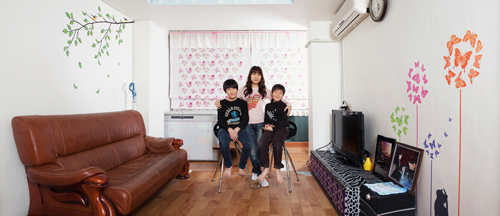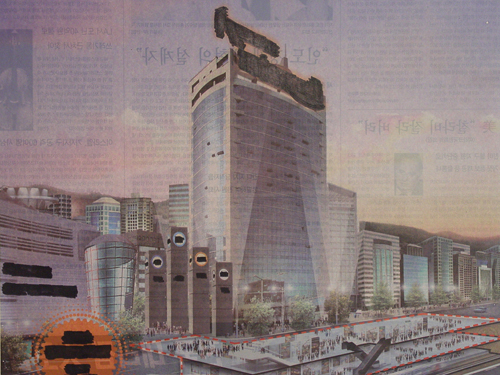News
November 2011
국제갤러리 전속작가 양혜규, 정연두 아트선재센터 그룹전 참여

정연두 Yeondoo Jung
남서울 무지개 Southern Rainbow Seoul
2011
photo installation

양혜규 Haegue Yang
그밖에서 Dehors
2006
Slide projection, looped, 2 sets of 81 color slide each, 2 slide projectors, dissolve control
전시기간: 2011년 11월 12일 – 2012년 1월 15일
전시기관: 아트선재센터
관람시간: 11am – 7pm (화요일-일요일) / 월요일 휴관
웹사이트: http://www.artsonje.org/asc
담당자: 전민경(02-3210-9885)
아트선재센터에서 도시(City)와 도시성(Urbanism)을 주제로 하는 전을 오는 11월 12일 개최한다. 이번 전시에는 국제갤러리 전속작가인 양혜규, 정연두 작가를 포함하여, 국제적으로 활발히 활동하는 17명의 국내외 작가들이 참여한다.
전은 도시 속에서 발생하는 균열과 마찰, 어긋난 배치들에 주목함으로써, 주어진 환경을 다시 돌아보고 나아가 상상하도록 하고 도시 공간을 보다 창의적인 탐구와 도전을 가능케 하는 대안적인 현장으로 바라본다. 본 전시는 건축과 도시성 그리고 환경 예술에 대한 고찰을 전제로 하며, 다양한 배경과 경험을 가진 작가들의 전시 작업들을 통해 인간 주체와 구축된 환경으로써 도시 사이에 드러나는 요소들을 다각적으로 조망하고자 한다.
본 전시는 사무소(Samuso)와 호주 멜버른의 거트루드 컨템포러리가 공동 기획하며 2012년 8월 거트루드 컨템포러리로 이어질 예정이다.
양혜규는 특정한 역사적 인물이나 구체적인 일상의 환경 등을 설치, 조각, 영상, 사진 등 다양한 매체를 아우르는 정교하면서도 추상적인 조형 언어로 번역해낸다. 양혜규의 작업은 변형된 것들, 일상에 잠재되어 있는 이질성의 의미망을 발굴해 내며, 구조적인 것과 임의적인 것, 형태, 기억과 같은 개념의 공존을 모색한다. 양혜규는 종종 전시 공간을 일반 기성품들로 채움으로써 친밀함을 주는 동시에 긴장감을 자아내는 곳으로 만들어낸다. 다층화된 감각의 구조물을 통해 관객들이 미술의 비전형적인 해석, 인간 삶의 조건과 정치성의 문제에 주목할 수 있는 틀을 제공한다.
<그 밖에서>(2006)는 부동산 개발을 선전하는 다양한 일간신문 광고 이미지를 슬라이드 필름으로 촬영하여 프로젝터라는 미디어를 통해 순차적으로 제시한다. 각 광고에 등장하는 건축물 이미지는 시공에 앞서 투자를 유치하기 위해 제작된 시뮬레이션으로, 편리하고 첨단적이며 누구라도 소유하고 싶은 상품적 유토피아를 재현하고자 과장된 광고 언어에 의거해 제작된 이미지이다. 진실의 해명과 현실 고발적인 언론의 기사들이 뒷면에 비쳐지며 공간에 대한 진실과 허구, 현실과 이상 그리고 기사와 광고의 이중적이고 공생적인 중첩을 시네마틱하게 보여준다.
<등대(오스람): 시간에 홀려서>(2010)는 작가의 광원 조각 제작 후 축적된 전구 상자들을 재료로 한다. 작가는 상품 포장재였던 종이 상자의 안과 밖을 뒤집어 광원 재료라는 본래 맥락의 상실을 은유적으로 표현하고 있다. 상자는 반복되는 단위로서 건축적 모형이나 벌집 같은 유기적 주거 형상에 대한 연상을 불러일으킨다. 이는 아이들의 놀이에서 볼 수 있는 반복적 증식을 통한 자유롭고 유희적인 즉흥성을 띤다. 안과 밖을 뒤집고, 재료의 기능을 등대로 해석하는 등의 기호-오브제적인 해석은 작품 본체를 둘러싸는 종이 글자들과 작품에 부제<시간에 홀려서>로 인해 시간성의 서사를 더한다.
정연두는 스스로와 주변 세계를 바라보는 우리의 특정한 시선을 재구성하고자, 사람들과 그들의 행동에 주목한다. 아이들과 함께 그들의 상상에 대해 작업하거나, 마법, 마법사, 영화, 극 사이의 연결점을 상정해 보는 등 실재와 상상 사이에 존재하는 세계들을 재현하기 위해 작가는 사진과 같은 매체와 연극적 퍼포먼스를 이용하기도 한다.
본 전시에서 작가는 2011년 작업 <남서울 무지개>를 선보인다. 이는 2001년 초상 연작 <상록타워>를 연상케 하는 작업으로, 금천구 시흥동에 위치한 남서울 무지개아파트에 사는 30여 세대 주민들의 집을 들여다본 사진 작업이다. 사람들이 실제로 생활하는 사적 영역에서 작업하는 것은 언제나 어려움이 따르는 일이다. 작가는 참여한 가족들에게 가족 사진을 제공하기로 하고, 이를 홍보하여 참여할 가족을 모으고 일정을 잡고 촬영을 진행하는 쉽지 않은 과정을 거쳤다. 이 과정을 거쳐 탄생한 초상들은 비슷한 구조의 공간에서 사는 사람들의 제 각각의 삶의 모습을 보여주는데, 이는 타인의 삶의 모습인 동시에 마치 거울을 보듯 우리의 삶의 모습을 비추어 보도록 한다. 나아가 서로 만날 새 없는 가족과 이웃들을 모이게 함으로써 우리가 사는 복합적인 도시에서 예술 작업이 하나의 소통의 수단으로 작동함을 보여준다.
Art Sonje will be opening City Within the City on November 12th, a group exhibition that will present works that explores cities and urbanism. The show will feature works by Kukje Gallery’s represented artists Haegue Yang and Yeondoo Jung, and 17 other internationally acclaimed local and foreign artists.
City Within the City examines the points of friction, the misalignments and the moments open to re-imagining where human subjectivity meets the built environment. Taking into consideration current thinking in areas connected to landscape urbanism and environmental art, City Within the City does not seek to literalize these debates. Instead the exhibition will uncover and interweave fictional, composite, fabricated and re-purposed narratives within these encounters.
The present exhibition is co-organized by Samuso and Melbourne Gertrude Contemporary, and will travel to Gertrude Contemporary in August 2012.
Haegue Yang translates her subjective reflections on specific historical figures and concrete domestic environments into a meticulous language of formalistic abstraction, ranging from installation, sculpture, and video to photography. Her practice explores the meaning of incongruities and mutations in our everyday life, seeking possibilities for how the structural could coexist with the arbitrary, the form and memories. Distinguished by her continuous conceptual focus, her exhibitions are often filled with industrially manufactured objects from everyday life. The space transforms into the site of intimacy as well as tension. Through these multi-layered sensorial structures Yang attempts to suggest a frame where the viewers can question the meaning of art and the political backdrop of our living conditions.
Dehors (2006) is a projection of successive images transferred as colour slides showing advertisements for new residential developments, which are taken from Korean daily newspapers. Each of these architectural images is a simulation made to attract investors prior to the actual construction of the building. They are fabricated to correspond to the exaggerated rhetoric of advertising, where the utopian vision of a desirable, cutting-edge dwelling or working environment is reproduced. As certain truths printed on the reverse of the page are accusatorially visible, the images cinematically overlap the duality and coexistence of the media and advertisement, the fake and the real, reality and idealism.
Haegue Yang’s Light House (Osram): Bewitched in Time (2010) re-uses cardboard light bulb boxes, which are a side-product of Yang’s light sculpture production. Yang turns the boxes inside out and metaphorically challenges the original context of packing material for lightings. Taking the boxes as repeating entities, the piece is reminiscent of architectural models or beehive-like organic dwelling systems. It shows the carefree and playful aspect common in children’s play, where repetitive expansion is typical. The action of turning inside out and the metaphoric interpretation of the original function ? package for lightings ? to “light house” make the piece a symbol-object. Also, a notion of narrative timeline is reinforced by the title of the work ? Bewitched in Time, and the Origami-formed letters surrounding the body of boxes.
Yeondoo Jung engages with diverse people and practices to construct glimpses of the particular perspectives through which they see themselves and the world around them. Whether working with children and what they imagine, or exploring links between cinema, magicians and live theatre, Jung employs photography and other technologies to create portraits, be they photographic or theater performances, of these worlds existing between the real and the imagined.
For City Within the City, Jung presents his recent series of family portraits, Southern Rainbow Seoul, reminiscent of his 2001 Evergreen Tower series. Since gaining access into the private sphere of people’s homes is difficult the artist employed a similar procedure in both cases: offering a photographic portrait of families willing to participate in the project. The images resulting from this process not only portray how different people inhabit similarly structured spaces but also work as a means of communication in the complex cities we inhabit by bringing together neighbours that given their schedules rarely have occasion to meet.
01
05


